Catering Business Plan Template – 11+ For Word & PDF
One of the most important elements of starting a new catering business is to have a plan that lays out your plans, objectives, and activities that will be needed to get your business off the ground. Even if it is on the back of a napkin , a plan that outlines how you will get started and answers many questions for you and your investors is better than nothing at all. A catering business plan can save a great deal of wasted time and money. Using a catering business plan template guides the new business owner through the areas they need to address as they launch their new endeavor . Nothing is missed, and the template saves even more time for the busy entrepreneur.
This blog reviews what a catering business plan template is, what the important elements are that should be in every business plan and address several frequently asked questions many readers have.

What Is a Catering Business Plan Template?
A catering business plan provides an overview of a catering business that is already in operation or one that you plan to initiate. The plan looks to the future regarding expansion plans, goals and strategies, and operation plans. These goals and strategies are turned into actions that the business owner will need to execute to meet their objectives. For example, growing the business by 20% could mean adding ten employees, finding a larger building, obtaining financing to purchase more equipment, and developing a marketing plan to expand markets into other regions.
Using a catering business plan template saves you time and forces the business owner to think about and answer many detailed questions about their business plans, goals, and objectives. Using a template also means that you have a professional-looking document that will impress financiers you may need to secure funding for your expansion plans. Lenders look for specific details to be included in the business plan. Without this information, the likely hood of receiving approval for funding is low.
While using a catering business plan template saves time, developing a business plan takes a great deal of time and effort to gather all of the information and apply it to the business you want to create. Many people just want to get started with the business, which can lead to costly mistakes to be made and jeopardize the business’s success. A catering business plan properly developed using a template will save the business owner from making expensive mistakes and improve the opportunities for the business to be successful.
Catering Business Plan Sample
Creating a catering business plan in Word allows for easy formatting and editing. Loading your template in word gives you a quick base for adding the details of your business plan. Word lets you make quick changes, and save them easily. It is compatible with most text formats, and is a good choice for professional documents.

Mobile Catering Business Plan Template

Catering Business Plan Template for Wedding

Wedding Catering Business Plan Template

A food catering business plan should include all your start-up costs, and your plan for operating at a profit. Getting a business loan will require submitting a quality business plan. A template will show you everything to include. A clear, readable format will ensure that your business gives a professional impression.
Catering Business Plan Format

Catering Business Start-up Requirement Template

Catering Business Plan

Outdoor Catering Business Plan Template

Catering Business Statement of Work Sample

Catering Business Plan Outline Template

Catering from home still requires a business plan to ensure you will operate properly. Using your homes resources for a business takes proper financial planning. Your appliances will wear out faster, and utilities will be higher. Including how to factor that into your costs and taxes will make running your business much easier.
Catering Business Plan Essential Factors

Catering Business Plan (FAQ)

Essential Elements of a Catering Business Plan Template
The following are the essential elements of a catering business plan template. We will expand on each of these to provide more details.
- Executive Summary
- Company Overview
- Catering Industry Analysis
- Target Market Profile
- Competitive Profile
- Marketing Plan
- Company Operations
- Management Team
- Financial Plan
- Executive Summary – typically one page in length, the executive summary shares with readers the objectives of the business and the vision or mission of the business. The executive summary is the last page to be finalized and should reflect in a broad overview your plans for your company over the next five years.
- Company Overview – describe your company, including the principles of the company, who owns the company, the number of employees, and the organization structure if you have one. If this is a start-up, include start-up costs in this section.
- Catering Industry Analysis – include in summary form information you have concerning the industry for the market you will operate in as well as general industry trends that demonstrate the growth of the industry.
- Target Market Profile – clearly describe your market for the area you will operate in. What demographics is your catering business aimed at? Will you focus on catering to weddings, business events, and large parties, or are you focusing on the consumer market, for example? Back it up with data that supports your decision to focus on the market you have decided to target.
- Competitive Profile – analysis of your competitors is an excellent task to complete. This data will help you understand who they are, what their target markets are, and their strengths and weaknesses. Finish off this section by describing your competitive advantage compared to your competitors, along with a risk assessment. Your competitors are not going to remain in their current lane. They will adapt to a new competitor coming into the market. How will they react to your entrance?
- Marketing Plan – once you open for business, letting people know that your company is in the catering business and getting your name out there is paramount to becoming successful. Outline your advertising plan – print, TV, Social media, etc. and how much advertising is going to cost. Your marketing budget needs to be factored into your budget.
- Company Operations –the catering business operations plan must factor in the catering services that will be offered, the functions of each employee, and the milestones or objectives that the operations team needs to hit to be successful and meet your financial targets. Equipment and supplies should be included, as well as space to operate and vehicles to transport all catering activities.
- Management Team – your catering business may start with one or two employees and quickly expand as orders arrive. Many catering companies have a combination of full-time employees and temporary staff. Describe the management team, the full-time employees, and where the temporary folks will come from. Hiring skilled, dependable employees is one of the most significant challenges many businesses encounter.
- Financial Plan – the financial plan is one of the most important sections of the catering business plan. It brings together all of the revenue, expenses, and capital purchases you need to make and how those funds will be used over time. Key assumptions should also be included covering all major issues affecting cash flow and capital expenditures. The catering business financial plan also should include an annual income statement, an annual balance sheet, and an annual cash flow statement. Lenders will examine these numbers in detail to assess how aggressive your plan is and the probability of your business achieving these numbers.Once the catering business plan is finalized, arrange for a 3rd party to review and critique the plan. Someone with experience in the catering business and someone with lending experience is a good choice for reviewing the plan before submitting it to potential lenders.
The following are some of the frequently asked questions many of our readers have about catering business plan templates.
Business plans are extremely useful for several reasons: ᐅ Support applications for support from lenders ᐅ Planning operations, resource needs, and managing cash flow ᐅ Assessing the company’s profit margin ᐅ Setting objectives and milestones ᐅ Planning the growth of the company ᐅ Annual updates help keep your company on track
One of the reasons a catering business plan is useful to both operators and lenders is the prediction of the profit margin. The profit margin is the revenue minus expenses. Accountants can assist with the development of the predicted profit margin taking into account your predictions for sales, operating expenses, and depreciation on capital equipment. Lenders expect a positive profit margin in the first year of approximately seven to ten percent.
The food cost formula is the ratio of the cost of food ingredients vs. the revenue generated by these ingredients. Food costs must consider many factors, including the cost of the ingredients, storage, waste, inventory costs, and support costs such as napkins and garnishes. Food costs are sometimes focused on the cost of the ingredients only to determine the basic cost of a serving. Overhead costs such as storage, waste, employee, and building costs are added to this number to determine profit per meal.
A strategic plan for catering front ends the catering business plan. The strategic business plan for catering helps establish and answer questions about: ᐅ The size of the business at launch and the ability to grow ᐅ The type of catering – weddings, corporate, etc. ᐅ The location of operations and the area served ᐅ How the business will be managed? Strategic planning may include: ᐅ Market competition analysis, ᐅ Feasibility analysis ᐅ Operations analysis
The importance of a catering business plan cannot be understated. There are many advantages for the owner to develop a business plan and use it to guide his business development and growth. Is the business viable with the current plans, or do you need to make changes to elements of the business to give it a better chance of success? Will lenders loan you funds to help get the business started? When should the business expand? Which markets and what is the competitive environment in the area the business will operate in? These questions and more should be addressed in the catering business plan to help make the business successful. Using a catering business plan template saves time and guides new business owners through the topics they need to focus on as they launch their new catering business. Nothing is missed, and the template saves even more time for the busy entrepreneur. There is an advantage to reviewing the business plan at least once a year or sometimes more often to determine if changes need to be made, verify assumptions, and incorporate new facts learned during the year. These mid-course corrections can help ensure that your business reacts to a dynamic market environment. Update the catering business plan at a minimum annually and review the plan with key management personnel. Lenders may demand to see an updated plan. They want to have confidence that their money is being used wisely and that they will see a return on the investment they have made in your business. An updated catering business plan may be a condition of continuing support from lenders. Use the catering business plan as a tool to help your business adjust to changing markets, supply conditions, staffing, and competition. With a business plan, making adjustments to sales projections can tell you quickly what the impact will be on the bottom line. Similarly, with adjustments to the price of goods, staffing, salaries, rent, etc.
How did our templates helped you today?
Opps what went wrong, related posts.

Food Truck Business Plans
Payment plan templates.

18 Sales Plan Templates and Examples

Test Plan Templates and Examples

Party Planning Checklist

14+ Free Birth Plan Templates (MS Word, PDF)

Social Media Marketing Plan Template – For (Word, PDF)

26+ Training Plan Templates and Checklists for Effective Training Programs
Thank you for your feedback.

- MARKETPLACE
- DOWNLOAD BUSINESS KIT
How To Write a Catering Business Plan w/ Templates (PDF, Word Doc)
Whether you’re starting a catering business full-time or planning to operate out of your house initially , writing a business plan is essential to getting clear on the type of catering business you want to open. After all there’s some pretty important stuff covered inside of what can seem like a stuffy document.
For the purposes of starting a catering company, think about the business plan as the one place you put your operation details. Things like the cooking equipment you need to purchase and the total cost, tentative catering menu, food costs, and who your target customer is. These are all super important details you need to understand before opening! This document provides a place for you to organize everything.
By the end of this guide, you’ll be able to draft your plan and start on that first catering gig you’ve been planning to open. We also provide templates you can use in PDF and Word Doc you can download and edit. Let’s get started.

Executive Summary
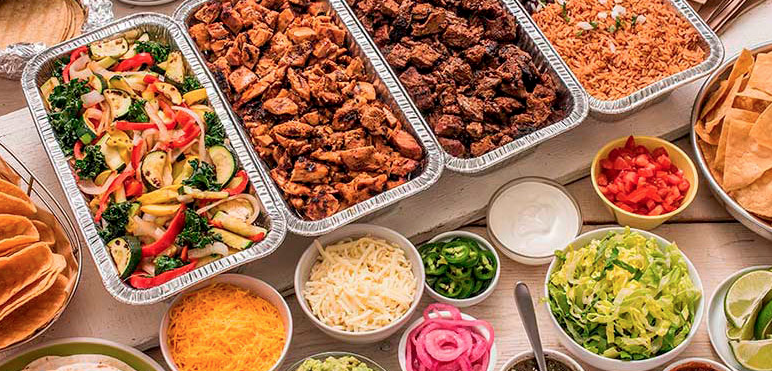
Catering spread for a Mexican food concept.
Start your business plan with an executive summary. This is a way to introduce your catering business so whoever is reading your business plan will know what to expect. This will include a brief introduction of your catering business, a description of your company, the services your catering business will be providing, and the customer focus.
Introduction
A quick introduction helps the reader get a bird’s eye view of your catering business. Here you’ll be talking about what to expect and what you can offer as part of your catering service.
This section isn’t considered lengthy. This usually has two to three sentences. What you need to focus on when writing this down is by the end of it, your reader will more or less understand what your catering business is all about.
Here’s an example introduction you can use as a guide:
The Big Spoon is a small catering business headed by Lydia Smith. She specializes in Italian cuisine but can cater to American, Mexican, and Asian dishes as well. The Big Spoon can accommodate an intimate dinner for 2 up to a large party of 50 accompanied with table settings and chafing dishes to complete that delicious home-cooked meal experience.
Just by the introduction, the reader will know how big your catering business is, what cuisine they can expect to order, and how many people the business can cater for. It also gives them an introductory glance about your catering style wherein you already provide more than just food but also a table setting so they don’t have to look for a supplier for this separately.
Keep your introduction informative but also short enough. You will be able to add in more to the details later on.
Company Description
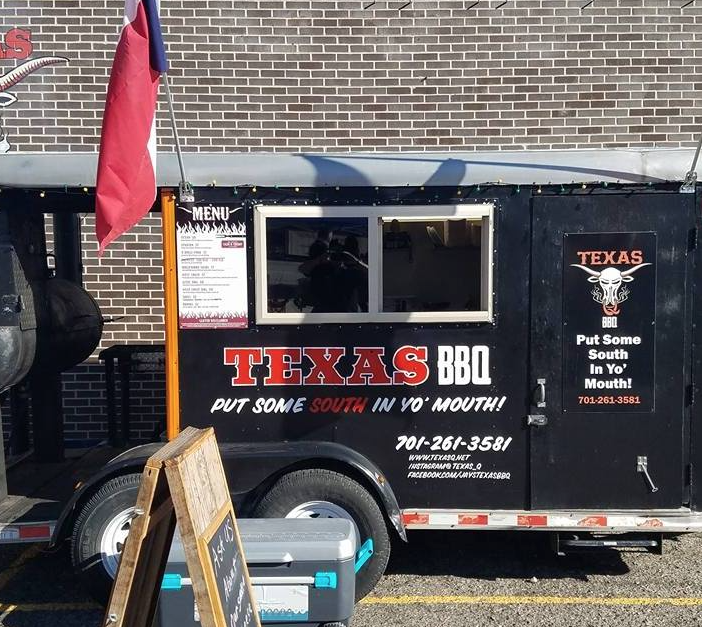
Some food trailers make more than 50% of their annual revenue from catering gigs.
A little background on your catering business is needed in the company description part of the business plan. Here, you can describe the meaning behind the name for your catering business, who the owners are, and what their roles are going to be. Who will be in charge of cooking? Who will be in charge of accounts and marketing?
This may just be brief but this is a way for you to introduce what’s going to happen behind the scenes of your catering business.
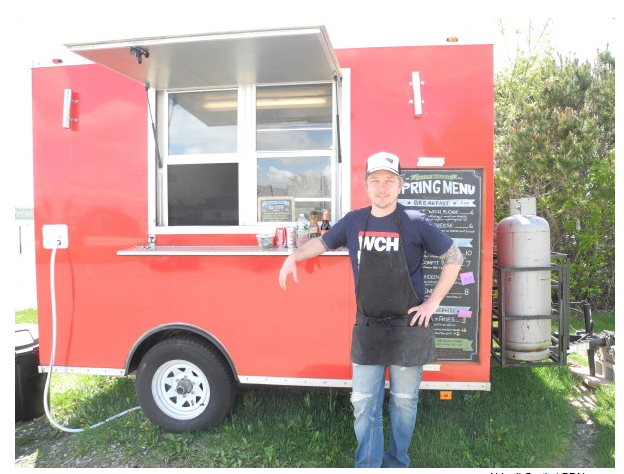
Catering works great for food trucks and restaurants.
Although your catering business may sound self-explanatory, it would still be of great help to you if you mentioned the services you’ll be offering.
For example, The Big Spoon already mentioned in their introduction that they’ll be catering food and offering table settings. They could also add that they will be offering an ice cream station and even a cocktail bar.
You will describe more of this in detail later on but you can summarize it and mention it here already.
Customer Focus
For a catering business to flourish, you must know your target market early on. And though a thorough explanation of that can be found in the Market Analysis section, you can briefly state them in this portion as well.
Also, remember that your customer focus would also have to coincide with your skills. You can’t be targeting customers who are vegans if your culinary skills and knowledge do not include cooking vegan food. This is why it’s important to write this early on so you can narrow down the customers you are planning to cater to.
Mission Statement

What’s your mission statement?
Businesses with clear goals stated from the start lead to a successful operation. Why? Because every decision you make revolves around these goals which will lead you closer to success.
Here’s a sample mission statement to picture it out clearly:
The Big Spoon aims to cater delicious home-cooked meals to its customers. Every dish that is served will contain natural and fresh ingredients. We see to it that the service we provide is top-notch so that our customers will feel as if they are being served in a fine restaurant in the comforts of their own home or wherever they choose to have us cater them.
By writing this down in your business plan, you and your staff will have to stand by the standards you’ve set for yourselves. For instance, as stated in The Big Spoon’s mission statement, no fast food will be served and no artificial ingredients will be used so you and your staff will always remember this by heart.
By following this and revolving your decisions around your mission statement, you will be able to keep such standards which will lead to pleased and returning customers.
Company Concept

This is the section of the business plan where you can finally put in detail the concept you’ve been planning for your catering business. Remember the things you’ve been holding back in saying in the introduction? This is the time to write them all down now.
Related Reading: 7 Powerful Ways I Promote and Market My Catering Business
You can start by answering the following questions:
- What cuisine will you be offering?
- How many people can you cater to?
- Will you be offering healthy options such as vegan, keto, or paleo meals?
You may also add in other concept ideas that are not mentioned above. Just make sure to cover everything so you can have a basis for your product line and services to be tackled later on.
Market Analysis
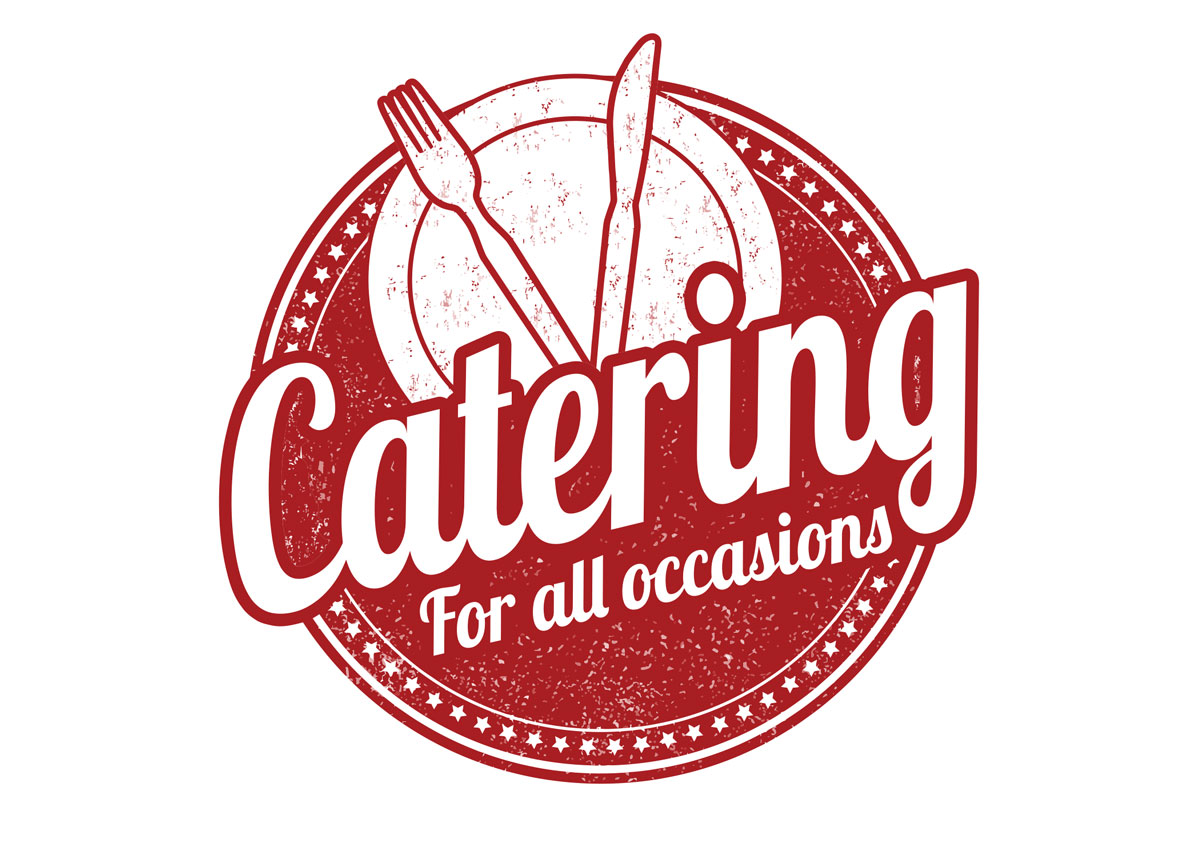
A compelling catering business logo.
Planning to put your business out there means you also have to know the industry you’ll be diving into. This is to help you analyze your potential customers, the growth of the catering business in your area, and the competition.
Target Market
As mentioned above in the customer focus, your skills will have to match your target market. You’ve already written a brief introduction about it so in this section, all you have to do is to explain it in detail.
Industry Analysis

The catering business has been going on for a long while now so it’s important to gather in as much information as you can regarding this industry. This is to help you figure out if there is a potential market for your business and how to put your plans into action.
Another helpful guide is to look into the type of cuisine most people in your area look for. You can then incorporate it into your business and offer it as part of your menu.
The bottom line is that analyzing the industry around you helps you plan better for the future of your catering business.
Competitive Analysis
You will not be the only catering business in your area. You’ll have to consider restaurants as your competition too. Check their prices and set menus. Do a competition check by tasting their food once in a while. Knowing who the players are in this competitive business game gives you the upper hand because you’ll be aware of their strengths and weaknesses and how to deal with them on the field.
Management Structure
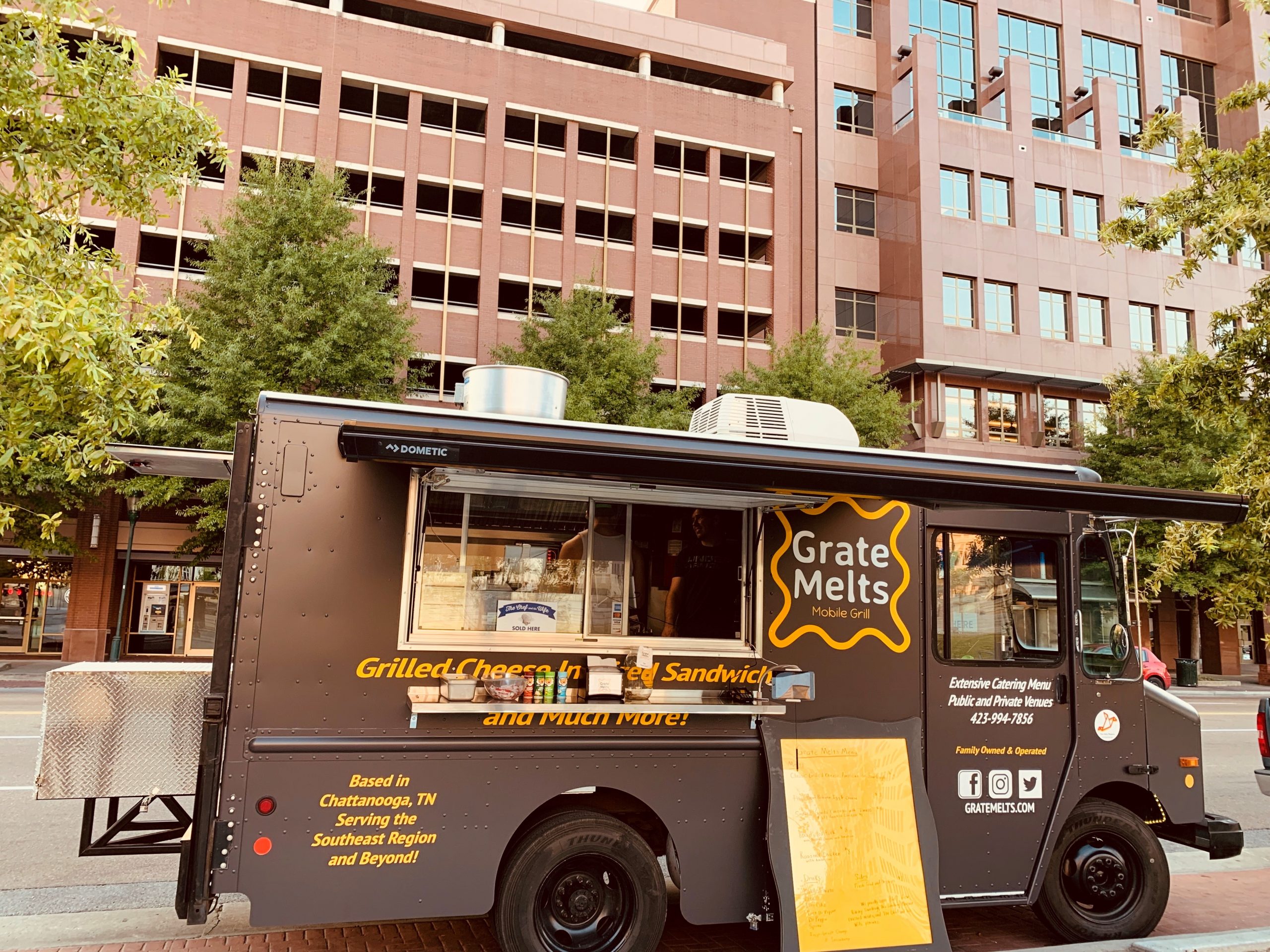
Determine the key players in your business.
A catering service is run by a few people. In this section of the business plan, you’ll list down everyone who is working on this business alongside you as well as the roles they possess in your business. This includes:
- Business Partners
- Accountants
- Co-chefs (If you’re not the only one doing the cooking)
Why is this so important, you might ask? Stating clear business roles and laying out the management structure keeps everyone in check and helps avoid any misunderstandings. Most businesses that don’t define this early on end up having a messy workflow. So make sure to state each duty clearly for everyone to follow.
Product Line and Services

Burgers are a proven catering option.
This section of the business plan goes hand in hand with your company concept. Here you can present your different sample menus for all the cuisine you wish to cater to. Be sure to include the prices for the set menus per head.
You can also write down the services you plan to offer. Here are some you can consider for your catering business:
- Out of town catering
- Cocktail station
- Set up style (buffet or plated)
- Table setting (formal or casual, rustic or summer feel)
- Wait staff or food display only
Writing them all down in this section will keep your business more organized which is very important when you start on your catering business.
Sales and Marketing
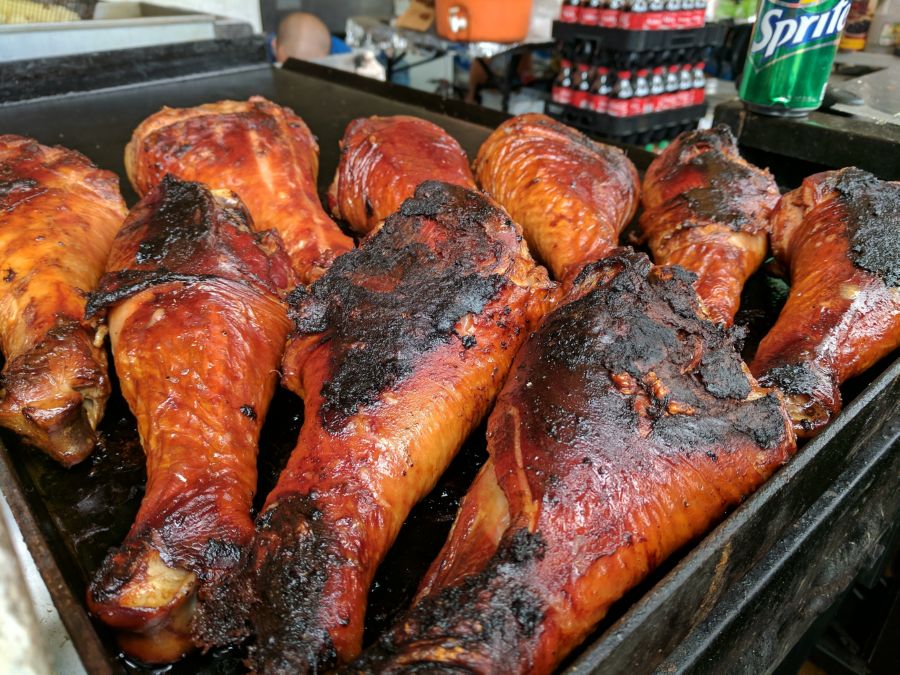
Grilled chicken is another popular option for caterers.
How are you going to market your catering business? Do you plan to have an ad out in your local newspaper and on social media? Both strategies are fine but you need to find more ways to get your catering business out there.
One way to market yourself is to partner up with rental spaces such as function halls that do not provide food. Give them a proposal that when there are inquiries regarding the rental of their halls, they would present your set menus to the guests as well so they don’t need to trouble over finding a caterer.
Related Reading: How I Started a Legit Catering Business Out of My House
Partnering with several event coordinators is also a way to get your business known. People these days hire event coordinators to do all the planning for them. They expect these coordinators to answer all their questions from food, music, and decorations. By partnering up with an event coordinator, they’ll be the ones to pitch in your catering business to their customers.
Remember to uphold your mission statement as well. By providing good food and high-class standards during your catering event, you’re already marketing your products and services to the number of people you’re catering to. So always make an exceptional first impression because that will stay with the guests long enough for them to remember hiring you on their next and succeeding events.
Financial Plan

Plan your financial future.
Knowing where you’re going to get the funds to start your catering business is a must. This is how you’ll know if your plans are going to be achievable or not. Besides, having a solid financial plan will also allow you to go through with your ideas without any interruptions.
In this section, break down your financial plan into two categories which are your plans to request for funding and your financial forecast.
Funding Request
Some business owners are ready to put up their catering business due to having saved enough money through the years. But what if you lack the funds to do it? Don’t fret. You can still loan from the bank and invite investors.
Whatever your plan is that deals with requesting for funding, include it here so you can document it.
Financial Forecast

Make conservative and best case scenario financial forecasts.
Reaching break-even is the ultimate goal when you’re putting up a business. You can compute how long it will take you to reach it early on in the planning stage.
You can also list down all your proposed expenses here which include the following:
- Pots, pans, and other large kitchen appliances and tools for cooking
- Chafing dishes
- Dessert displays and trays
- Table cloths, plates, glasses, and utensils
- Uniforms for you and the staff
- Storage boxes and food warmers
You may also add in tables and chairs if you do not want to keep on renting these. But sometimes, the venue where you’ll be catering can provide these as well.
Download Now: Bakery Business Plan Templates for 2021
Be sure to include your staff’s payroll expenses. Since catering events are not done daily (unless you’ve already made a name for yourself and you’re booked every day), you can just have your wait staff be on call and pay them per catering event rather than a daily wage.
By computing these, you’ll know just how much you should allot for your startup capital and how much should your goals be to reach during every catering gig in order to profit off of it.
Operational Plan

What’s your operation plan?
Put your plan into action by making a timeline of your operations. Here is an example:
Date Plan [Insert Date Here] – Finalize the business documents you need such as permits and registrations for your catering business.[Insert Date Here] – Start marketing your business on social media and the local news. Send out proposals for partnerships with event coordinators and function halls.[Insert Date Here] – Hire and train staff.[Insert Date Here] – Start catering when booked.[Insert Date Here] – Achieve goals and reach break-even.
The appendix section of the business plan is where you can put all your documentation. This includes photos of your food and table setting and your copies of the permits and registration for your catering business.
Download Templates
Here are the catering business plan samples in PowerPoint, Word Doc, Google Doc, and PDF. These are ideal for commercial or home-based catering businesses.
- Catering business plan template Google Doc
- PDF catering business plan sample
- Catering PowerPoint template
- Catering businesses are ideal because there is no space for you to rent which is considered one of the main expenses that can be quite heavy on the pockets. You will be cooking in the comfort of your own home. Just make sure your place can handle heavy cooking and there is enough space for you and your staff to move about.
- It would be nice to learn more about the different cuisines as you go along so you can cater to a wide variety of audiences.
- Include a checklist of all the equipment you need to operate at the start. These equipment requirements make up the bulk of your startup costs. You can download a checklist of frequently used catering equipment here .
Throughout this entire guide, we have been referring to your readers as one of the main reasons why you should make your catering business plan easy to understand. But in truth, making this business plan is for you as well. You will need this plan when you’re requesting for financial assistance in banks and this would also serve as your work guide. So remember to keep it detailed and easy to comprehend because you will be using this on the road to putting up your business.
While opening a catering business can be extraordinarily rewarding there are a few factors you should consider before deciding to push ahead. Creating a business plan lets you understand what the factors are, what’s going to make this business become a success, and how you can profit from the venture.
If you’re serious about starting a catering business, don’t forget to sign up for our Food Business Startup Kit . This free community will give you access to exclusive interviews with catering professionals you can use to help grow your own business.
Want to start your own food business?
Hey! I’m Brett Lindenberg, the founder of Food Truck Empire.
We interview successful founders and share the stories behind their food trucks, restaurants, food and beverage brands. By sharing these stories, I want to help others get started.
If you liked this story, sign up for our newsletter that includes our food business startup kit and most popular interviews sent straight to your inbox.
Know someone interesting that should be interviewed on the website? Tell us about them here.
About the Author: Brett Lindenberg
Related Posts

175+ Brilliant Food Tasting Event Names For Your Consideration
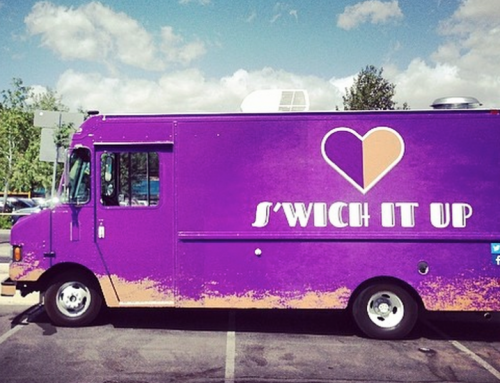
Corporate Catering Business: How to Find and Close More Leads
Wedding receptions: how to pull-off an unforgettable catering service guide.

Download Now: The Ultimate Catering Equipment Checklist for Beginners

IMAGES
VIDEO